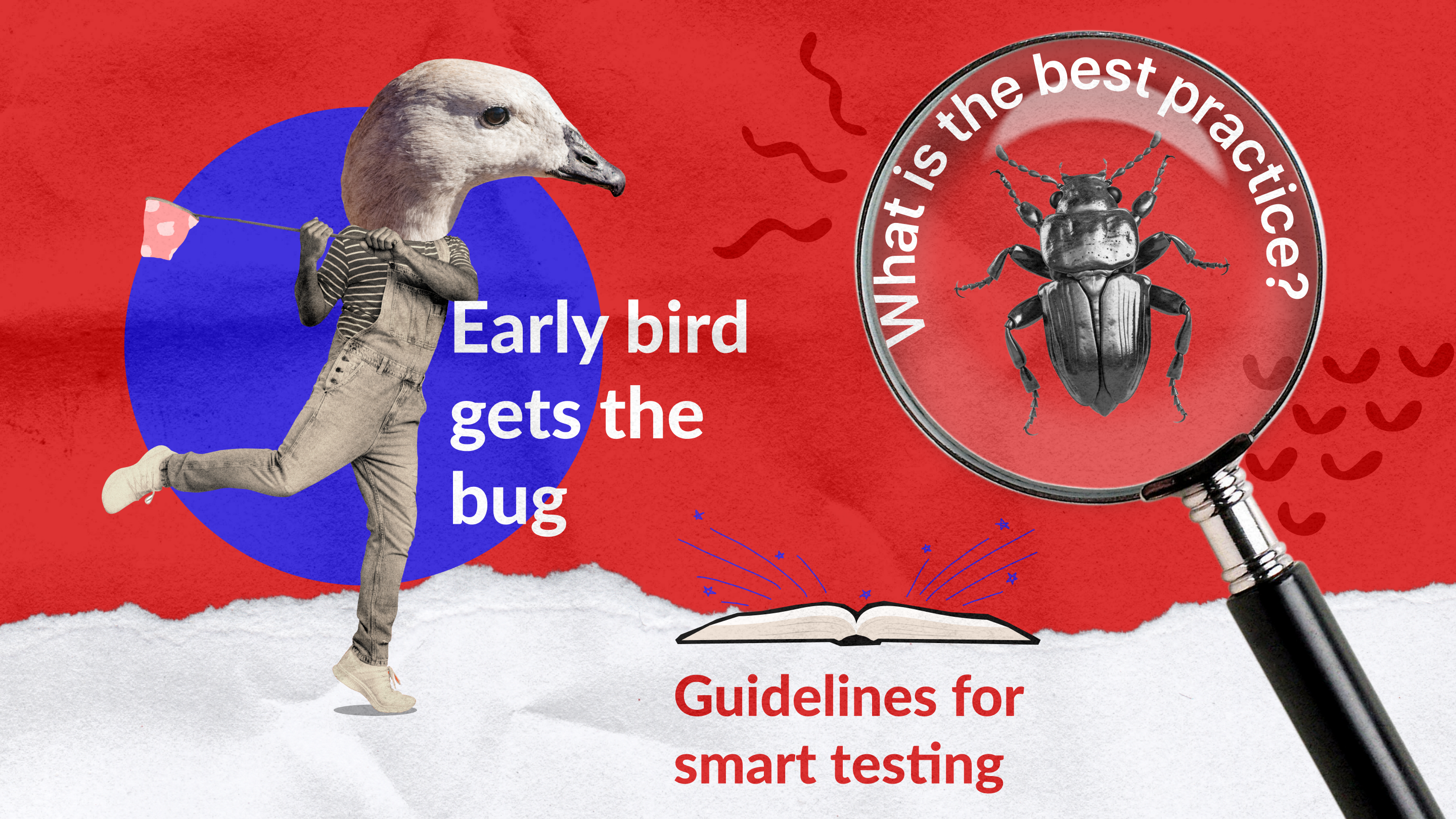Raise your hand if you have experienced an unreasonable lack of organization, poor scheduling, and daunting bug reports. Okay, there is no point in sitting in front of your computer with your hand in the air. After all, it is not very suitable for serious C-level executives. So here are 7 software testing best practices that will help you achieve a smoother software testing process, so you can respond faster to market changes.
Nowadays, businesses must actively work to raise the value of their products in the digital market by foreseeing changes, anticipating them, and producing appropriate updates for their audience.
Let’s deal with software quality management, quality assurance, quality control, and testing, which are the most crucial components. Fewer bugs bring more bucks.
Dive into 7 testing practices that will help you get the most out of the bug-hunting process.
1. Early Bird Gets the Bug: Integrate QA From the Start
By involving QA early in the process, right from the requirements phase, you set the stage for a smoother development cycle. When QA is looped in at the beginning, it becomes part of the planning and design conversations. This early involvement allows QA engineers to understand the project’s vision and objectives deeply.
Ensure the software meets the business goals and user expectations from day one.
Take requirement testing, for instance. QA professionals review the requirements for clarity, testability, and completeness. They might ask questions like, “Are these requirements realistic?” or “Do these features fulfill the user’s needs?” This proactive approach can validate that the team is building the right thing before spending too much time and resources.
Getting QA in the game from day one keeps everyone clued in, nips potential hiccups in the bud before they bloom into budget-eaters, and ensures we’re crafting a product that hits the mark with users.
2. Select Test Devices That Are Relevant to Your Product’s Audience
Even if it might sound obvious, it does not mean that everyone does it properly. According to the 2023 Global Digital Population report, around 96% of internet users access the web via mobile devices, yet the types of devices vary significantly across different regions and demographics. For example, older users might lean towards devices with larger screens or specific accessibility features, while younger demographics often opt for the latest, high-tech models.
The gaming industry exemplifies the importance of this approach. A mobile game developer focusing on high-end markets must test on the latest devices to ensure optimal graphics and performance. In contrast, targeting emerging markets where older models are more common requires testing on those specific devices to ensure smooth gameplay.
So here is what you need to do to make sure you test on relevant devices:
- Understand the prevalent devices and operating systems among your target demographic
- Create and regularly update a matrix categorizing devices by their popularity and relevance to your audience
- Employ cloud services that offer access to numerous device configurations
- During beta testing, use feedback mechanisms to collect data on device-specific performance issues from real users
Imagine you’re running a global streaming service like Spotify. How do you ensure that millions of users get a seamless experience on different devices? Spotify nails it by combining in-house testing labs with cloud-based platforms. This combo lets them mimic real-world usage across hundreds of devices.
Besides just hardware emulation, they simulate different network environments (like 3G, 4G, WiFi speeds), battery conditions, and more. By creating a mini-version of the world inside their labs, they can foresee and fix potential glitches before they ever hit your screen.
Test on real devices. Just like we did for our client Unfold, which is probably people’s favorite stories app. For them, we chose seven iOS devices with iOS 10-13 versions and eight Android devices with Android 5-10 versions. All the testing was done on real devices to achieve maximum precision in results. Additionally, we relied on BrowserStack, which allowed us to test our applications on a wide range of devices, operating systems, and browsers without needing to maintain physical hardware.
Check out the bug we stumbled upon while testing the app on Android. Can you spot it right away?

❌ Actual result: The black spinner is always displayed in the ‘For you’ and ‘Effects’ tabs after switching to different tabs on the home screen.
✅ Expected result: The spinner isn’t displayed.
3. Complete QA Software Testing Overnight
Don’t let your testing sleep even if you do. It might seem like we are forcing you to work 24/7, but in fact, we are offering to take some burden off your shoulders.
If you do daytime operations in North America, Australia, and New Zealand, you can conduct tests during the nighttime hours in Eastern Europe. While you sleep, our team diligently ensures that any updates, builds, or staging changes are thoroughly tested and ready for feedback at the start of your next business day.
What benefits do you get?
- Accelerated development cycle: wake up to the results of overnight testing and jump straight into action. By the time your developers are back at their desks the next morning, they have a detailed report with actionable feedback. This seamless integration of testing and development cycles can reduce your time to market by a significant 20%
- Quality and efficiency: improve the quality of your applications with detailed, undisturbed overnight testing that doesn’t overlap with your local working hours, so you can reduce the overall development timeline
For instance, when we worked with Arctype, an SQL client and database management tool based in Palo Alto, we used the difference in time zones to speed up their software releases by 20%. By testing their software during nighttime in their country, we ensured that their updates were ready for review by the start of their next business day.
Similarly, with PIXO Inc., a mobile app developer in Seoul, our time difference allowed us to accelerate their development process. While PIXO developers logged off for the night, our QAwerk team conducted thorough testing during our business hours. This ensured that PIXO had fresh bug reports ready each morning.

4. Try Testing Software on Beta OS
By engaging with new versions of operating systems during their beta stages, you can ensure that your software remains compatible and performs optimally even as new technologies emerge. For instance, when a new OS version is announced, accessing it during the beta phase gives developers a crucial head start. This applies to catching bugs and understanding how new system-level changes affect your application in real time.
Here are ways to do it:
- Enroll in developer beta programs for operating systems. This access is invaluable for staying ahead of the public release cycle and preparing your applications for new features and security updates
- Implement automated regression testing to quickly determine how new OS versions impact existing functionality. This helps identify discrepancies that could degrade the user experience
- Use CI systems to automatically test your code on new OS versions as soon as they are available. This integration ensures consistent checks and balances throughout the development process
Our team is part of the Apple Developer Program, so we have early access to the iOS update developer beta. From experience, we know that third-party apps need time to tweak their software to the latest iOS release. So why not do it beforehand to give users a better experience? iOS updates usually include changes to SDK methods or UI conventions, which will inevitably affect your app’s performance. Here’s an example of a gap between a new iOS and a popular communication app.

❌ Actual result: Stickers In WhatsApp are sent as images.
✅ Expected result: Stickers must be sent as stickers – without background and animated.

❌ Actual result: Stickers in WhatsApp disappear when you tap and hold them.
✅ Expected result: Stickers shouldn’t disappear.
5. Smart Automation: Where and When It Counts
Automation is not a one-size-fits-all solution. Implementing automation testing is mainly about selecting the right scenarios and understanding their limitations. The key is to automate intelligently – focus on those repetitive tasks that sap your team’s time and energy.
Guidelines for Smart Testing:
- Pinpoint where automation shines. For instance, consider an online store’s checkout process – something that’s used daily by thousands. Automating tests for login, shopping cart functionalities, and the checkout process saves you time during regression testing and also ensures that these critical user paths work flawlessly with every new release. This is automation at its best: routine yet crucial
- Watch out for the quirks. However, temper your automation enthusiasm with a dose of reality. If parts of your product are in flux or features are still being rapidly developed, hold off on automating these areas. Frequent changes can make automated tests fragile and maintenance-heavy
- Know what to keep manual. For example, avoid automating tests that involve intricate third-party interactions or complex user scenarios involving multiple stakeholders. These elements are prone to variability that automation can’t reliably handle. Testing integrations with external payment gateways or real-time collaboration features often requires a manual touch
For tasks that demand a human perspective, consider incorporating usability testing into your QA process. This ensures that your software not only functions correctly but also provides an intuitive and seamless user experience.
As part of our usability testing services, we check that the application’s design matches its functionality, verify the usability of application functions, proper navigation, correct display of text content, font design, and other aspects that affect user interaction with your software.
6. Document To Dominate: The Power of Early Test Documentation
By thinking ahead about test documentation—from checklists in the early stages to detailed test scripts later—you ensure that your testing is a staple of your project from start to finish.
From day one, your QA team should start with simple checklists. These are quick to create and easy to follow, covering basic yet crucial aspects of the initial functionality. For example, a startup developing a mobile app might have a checklist that includes items like app installation, user login, and primary navigation. These checklists ensure that even the most basic features align with the user’s needs, preventing any “Oh no” moments later on.
Moreover, sharing checklists for repeated features between projects can streamline the testing process across multiple teams and products. By reusing proven checklists, you save time and ensure a quality threshold regardless of the project. Imagine how much time and miscommunication it can save you if you work on multiple similar applications.
As the project matures, these checklists evolve into more comprehensive test scripts. For instance, consider a company like Uber, which might develop test scripts for booking a ride, handling fare calculations, and managing user feedback. These scripts help systematically verify each function against specified requirements.
Taking this structured approach to test documentation helps get developers and testers on the same page: everyone knows what needs to be tested and why. Fewer questions and fewer mistakes reduce downstream costs and delays.
7. Beta Testing for Better QA Testing
Launching a new feature or product without beta testing is like stepping on stage without a dress rehearsal – you might pull it off, but it’s a risky business. Beta testing with real users helps catch unexpected bugs and understand user behavior that you can’t get from in-house tests alone.
For example, Snapchat had a Beta Testing program for its Android app redesign to test how people would use Snap Map. By engaging a diverse user base, Snapchat collected feedback that led to UI/UX adjustments. This direct user input helped identify and resolve critical bugs specific to certain Android versions before the broader release. As a result, they had a stronger market debut and better user retention.
While beta testing is not automated, the test cases that emerge from beta testing can be added to the regression test suite and automated for frequent execution. This ensures that once the feature is fully integrated into the product, any updates or changes can be smoothly implemented without disrupting its functionality.
Summing Up
Embrace these software testing best practices if you want to stay competitive. By implementing effective QA strategies, businesses can save money on omitting mistakes and get their product to market faster.
Every step contributes to delivering high-quality products that meet user expectations, from selecting relevant test devices to leveraging smart automation and early bird testing strategies. Integrating QA from the start and documenting testing processes reduces costs in the long run. Finally, beta testing with real users allows businesses to catch bugs and understand user behavior to make a stronger market debut and get better user retention.
If you do daytime operations in North America, Australia, and New Zealand, leverage the geographical advantage by having a team in Eastern Europe test your software after hours. Get updates, builds, or staging changes that are thoroughly tested and ready for feedback at the start of your next business day.
When it comes to optimizing your work processes, skimping on testing software is a gamble you can’t afford.
FAQ
What are the advantages of overnight testing in software development?
Overnight testing leverages global time zone differences to turbocharge productivity and trim down the software development lifecycle. With tests running in places like Eastern Europe while North America sleeps, teams can kick-start their day with comprehensive results and instant feedback. This strategy fosters rapid iterations and swift issue resolution, slashing time to market and enhancing overall development efficiency.
What is the best practice for testing your application?
The best practice for testing your application involves understanding requirements, strategic test planning, meticulous test case design, early testing adoption, integration of various testing types, efficient bug reporting, and engaging non-testers in testing endeavors.
What are the main testing strategies used in software testing?
There are three main software testing methodologies in software testing.
- Functional Testing that focuses on user stories and requirements through manual and automated means
- Integration Testing that verifies interfaces and data flow between components
- Performance Testing that ensures system performance through load and stress tests
See how we helped Arctype achieve app stability and accelerate releases by 20%


